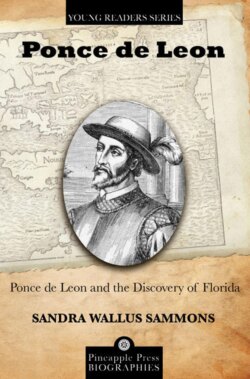Читать книгу Ponce de Leon and the Discovery of Florida - Sandra Wallus Sammons - Страница 9
На сайте Литреса книга снята с продажи.
ОглавлениеChapter 2
Christopher Columbus Finds a New World
On August 3, 1492, a very excited forty-year-old Christopher Columbus sailed west. On his three ships, the Nina, the Pinta, and the Santa Maria, were about 200 men and supplies for a long voyage. The trouble was, Columbus did not know how long the voyage would be.
There had probably been others who ventured out into this “Ocean Sea” (the Atlantic Ocean) before 1492, but Columbus had no records of their journeys. The Nina, the Pinta, and the Santa Maria were sailing into unknown waters. According to the maps Columbus had studied, Japan and China were on the other side. But he didn’t know that for sure. He hoped the maps were not mistaken.
Trade winds helped to push the ships across the miles and miles of ocean, but after weeks of not seeing land, the men became discouraged. They urged Columbus to turn back, to return to Spain. Suddenly land was sighted in the distance!
Columbus was right. If you sailed far enough across the ocean, you would come to land. And Columbus hoped that Toscanelli’s map was correct. Surely they had reached the East Indies.
They landed on October 12, 1492. They looked around them. The sun lit up the cobalt blue and emerald green colors in the water. There was an amazing variety of palms and lush plants covering the land. It was different from home, but, thought Columbus, was it Japan, China, or India?
A drawing of Christopher Columbus, his men, and the natives on Hispaniola, 1492 (Courtesy of the State Archives of Florida)
Whatever it was, they felt they should claim the land for Spain. As the men placed the flag of Spain in the sand, eyes were watching from the bushes. The natives, who had lived there for thousands of years, were cautious because neighboring tribes would sometimes come to attack their villages. They looked over the newcomers carefully.
Columbus and his men seemed to be friendly, and they were certainly different from anyone else who had landed on their island. The natives thought they must have come from the sky! When the strangers offered gifts, the natives welcomed them.
While the natives looked over the strangers, Columbus was also trying to figure out the natives. They didn’t look like the Chinese whom Marco Polo had described. But still hopeful that he had really reached the East Indies, Columbus noted in his log book that he had met the natives, and they were “Indians.”
The natives loved the glass beads and other trinkets the visitors had brought. They also gave gifts. Beautifully colored live parrots were presented to the Spaniards. The Indians then allowed the men to look over their island. Columbus named the beautiful island San Salvador, in honor of the Savior of their Catholic faith.
There were many natives on this island and on other islands nearby. They grew their own vegetables and ate fish from the ocean. They made their own pottery and had their own religion and culture.
The Spaniards stayed a short time on San Salvador and then sailed to other islands. Again the Indians were friendly. On one island, which Columbus named Hispaniola, his flagship ran aground on a sand bar. Unable to fix the Santa Maria, Columbus had to leave it, along with about forty men, on that island. He told them to start a new settlement, which he named Villa de la Navidad, or Town of the Nativity.
After making such tremendous discoveries about what was across the Ocean Sea, Columbus was anxious to return to Spain to tell the king and queen about his adventure. Leaving food and supplies for the men who would stay at La Navidad, Columbus assured them that he would return soon with more settlers and supplies. Taking some of the parrots, a small amount of gold, and other gifts from the natives, Columbus found his way back to Spain.
There was much excitement when Columbus met with the king and queen, and he gladly answered their many questions. They had traveled uncharted seas and found unknown lands. They had made the voyage and returned after more than 200 days to tell about it! It was an amazing accomplishment.
King Ferdinand and Queen Isabella realized their money had been well spent on what had seemed a crazy idea. No one, not even Columbus, was sure if he had reached the East Indies, but right now they concentrated on what he had found!
For his bravery, the royal couple gave Christopher Columbus the title of Viceroy and Admiral of the Ocean Sea. He would also be called Don (or Sir) Christopher Columbus. And his eldest son would inherit those titles after his death.
The word spread throughout Europe, and young Spanish soldiers who no longer had to fight the Moors were listening. They, too, then dreamed of exploring this unknown world. Perhaps they, too, could find adventure, and perhaps riches, beyond the Ocean Sea.
One of those young soldiers was Juan Ponce de Leon.
